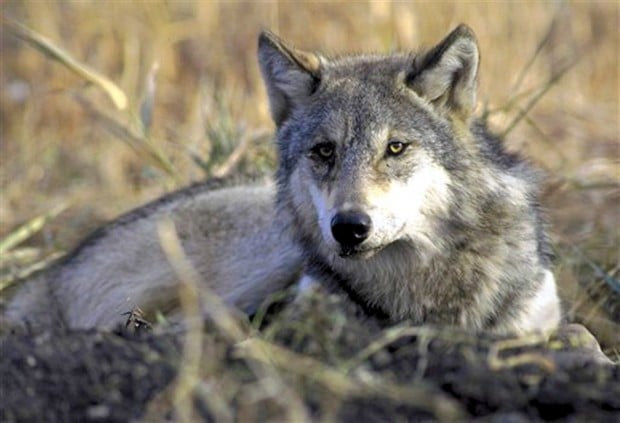MISSOULA — Montana wolf trappers came up empty on the first weekend of the state’s new wolf trapping season.
That’s not surprising, said Montana Fish, Wildlife and Parks Region 2 wildlife manager Mike Thompson.
The season just opened Saturday and it will take trappers some time to get their traps set, he said.
Under the new season’s regulations, trappers are required to call FWP’s reporting line within 24 hours of capturing a wolf.
In Western Montana, close to 1,000 people completed the mandatory wolf trapping classes necessary to participate in the state’s first wolf trapping season this year.
Thompson expects that relatively few of those will actually make the investment in cash and time to take part in the season.
“It’s an expensive thing and very time consuming,” he said. “It’s not for everyone.”
Thompson said the most inexpensive wolf trap that he’s seen so far costs about $50.
Once people have the traps, then they have to learn how to successfully set them in a place where a wolf might actually pass.
That’s not easy.
“It’s not like wolves are standing in one spot,” he said. “They move around quite a bit. To get one to put its foot in exactly the right spot isn’t an easy thing. There’s just not a high probability of that happening.”
State and federal wolf specialists have a good deal of experience trapping wolves. They’re fortunate to catch a few a year.
“They work pretty hard at it, too,” he said. “Trapping in the winter months presents its own challenges. Traps freeze and thaw. It’s not always easy to get around.”
In Idaho, trapping accounted for about half of wolves killed last year during that state’s wolf season. In 2011, hunters shot 255 wolves in Idaho and trapped another 124.
“In Idaho, a trapper’s primary tool is snaring,” Thompson said. “We’re not doing that here.”
Wolf trappers are required to visually check their traps at least once every 48 hours. The law requires that wolf traps be set at least 150 feet back from roads or trails, and 1,000 feet from trailheads or public campgrounds.
Other furbearer traps can be set 50 feet from a trail or road and 300 feet from a trailhead.
FWP officials said dog owners can minimize the risk of their pets being caught in a trap by keeping pets close when recreating on public lands and sticking to well-traveled routes. They also can look for signs of trapping activity, which could include a lightly traveled snowmobile track or some footsteps in the snow headed off a trail.
If a dog is captured, two large vice-grip pliers can open a foothold trap and quality cable cutters can cut a snare that trappers sometimes use for other furbearers. FWP offers an instructional brochure to explain how to release animals from traps.
source
That’s not surprising, said Montana Fish, Wildlife and Parks Region 2 wildlife manager Mike Thompson.
The season just opened Saturday and it will take trappers some time to get their traps set, he said.
Under the new season’s regulations, trappers are required to call FWP’s reporting line within 24 hours of capturing a wolf.
In Western Montana, close to 1,000 people completed the mandatory wolf trapping classes necessary to participate in the state’s first wolf trapping season this year.
Thompson expects that relatively few of those will actually make the investment in cash and time to take part in the season.
“It’s an expensive thing and very time consuming,” he said. “It’s not for everyone.”
Thompson said the most inexpensive wolf trap that he’s seen so far costs about $50.
Once people have the traps, then they have to learn how to successfully set them in a place where a wolf might actually pass.
That’s not easy.
“It’s not like wolves are standing in one spot,” he said. “They move around quite a bit. To get one to put its foot in exactly the right spot isn’t an easy thing. There’s just not a high probability of that happening.”
State and federal wolf specialists have a good deal of experience trapping wolves. They’re fortunate to catch a few a year.
“They work pretty hard at it, too,” he said. “Trapping in the winter months presents its own challenges. Traps freeze and thaw. It’s not always easy to get around.”
In Idaho, trapping accounted for about half of wolves killed last year during that state’s wolf season. In 2011, hunters shot 255 wolves in Idaho and trapped another 124.
“In Idaho, a trapper’s primary tool is snaring,” Thompson said. “We’re not doing that here.”
Wolf trappers are required to visually check their traps at least once every 48 hours. The law requires that wolf traps be set at least 150 feet back from roads or trails, and 1,000 feet from trailheads or public campgrounds.
Other furbearer traps can be set 50 feet from a trail or road and 300 feet from a trailhead.
FWP officials said dog owners can minimize the risk of their pets being caught in a trap by keeping pets close when recreating on public lands and sticking to well-traveled routes. They also can look for signs of trapping activity, which could include a lightly traveled snowmobile track or some footsteps in the snow headed off a trail.
If a dog is captured, two large vice-grip pliers can open a foothold trap and quality cable cutters can cut a snare that trappers sometimes use for other furbearers. FWP offers an instructional brochure to explain how to release animals from traps.
source


No comments:
Post a Comment